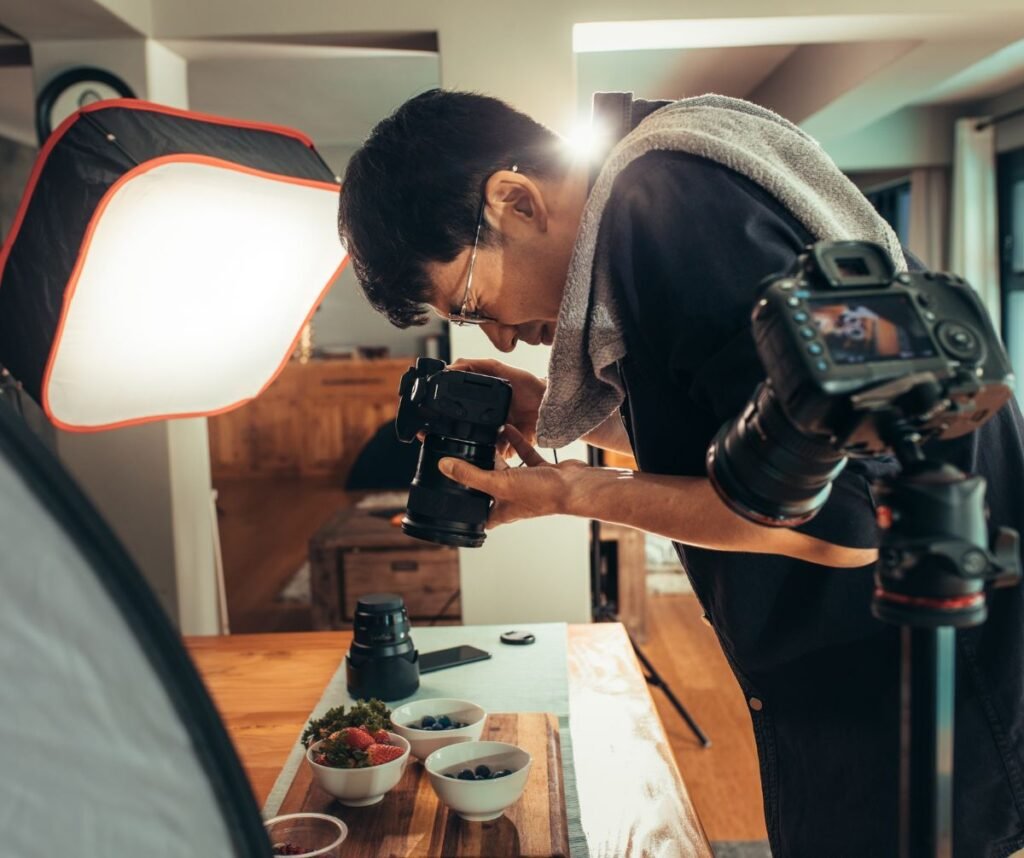Food photography plays a crucial role in the success of blogs and businesses in the food industry. In this section, we will explore the importance of food photography and the benefits of mastering this skill.

Essential Equipment for Food Photography
To capture stunning food photos, having the right equipment is essential. The choice of camera plays a significant role in achieving high-quality images, with options ranging from DSLRs to mirrorless cameras known for their versatility.
Selecting suitable lenses is equally important, as they allow you to capture details, create depth of field, and showcase the food’s textures effectively.
Tripods and stabilizers guarantee stability and prevent camera shake, resulting in sharp and well-composed photographs. Lighting tools, including diffusers and reflectors, enable the control of lighting conditions, whether you’re using natural or artificial light sources.
By procuring the appropriate equipment, you establish the basis for taking exceptional food photos.
Composition and Styling
Composition techniques play a crucial role in creating visually appealing food images. The rule of thirds, for example, guides you to position key elements of your composition along imaginary lines and their intersections, resulting in a balanced and pleasing arrangement.
Additionally, understanding colour theory enables you to select complementary or contrasting colours to make your food photos visually striking. Props, such as utensils or garnishes, can add context and visual interest to your compositions.

Backgrounds and textures, whether it’s a rustic wooden surface or a clean marble backdrop, help set the mood and enhance the overall aesthetics of your photos.
By employing these composition techniques and incorporating thoughtful props, backgrounds, and textures, you can elevate your food photography to new heights.
Lighting Techniques for Food Photography
Lighting plays a critical role in food photography, significantly impacting the overall quality and aesthetic appeal of your images.
Understanding the difference between natural lighting and artificial lighting is essential, as each offers unique characteristics and possibilities. Natural light can create a soft and warm ambience, while artificial light provides more control over intensity and direction.

Techniques for controlling shadows and highlights, such as diffusing harsh light or using reflectors to bounce light onto the subject, are essential to achieve a well-balanced and visually pleasing result.
Exploring the use of lighting accessories like diffusers, reflectors, and even light tents can further enhance your ability to manipulate and shape light for the desired effect.
Setting Up the Shot
Mastering the art of setting up the perfect food shot is a skill that can truly elevate your food photography. It entails understanding how to plate and arrange food in an attractive and visually appealing manner.
By paying attention to the placement of ingredients, colours, and textures, you can create a visually stunning composition. Choosing the right angles and perspectives is also crucial to highlight the most enticing aspects of the dish.
Experimenting with different angles can provide a fresh and unique perspective. Framing your shots effectively helps draw the viewer’s attention to the focal point of the image.
Additionally, exploring motion and action shots can add a sense of dynamism and energy to your photographs, bringing the food to life.
Post-processing and Editing
Editing is an integral and essential step in the food photography process. It allows you to refine and enhance your images to achieve the desired aesthetic and quality.
There are various software options available for editing, providing a range of tools and features to elevate your food photos.
Adjusting exposure, colour, and white balance can help bring out the true essence of the food, ensuring accurate representation. Enhancing food details and textures adds depth and visual appeal to your images, making them more enticing.

Mastering photo editing enhances food photography by removing imperfections and creating a professional appearance.
Honing Your Food Photography Skills
Engaging in regular practice is key to improving your food photography skills. One effective way to enhance your skills is by experimenting with different food subjects.
By exploring a variety of dishes, ingredients, and compositions, you can broaden your creative horizons and discover new techniques.
Additionally, trying out various lighting setups allows you to understand how different lighting conditions can impact the mood and aesthetics of your images.
Analyzing and learning from other accomplished food photographers is another valuable practice. Studying their work, composition choices, and editing styles can inspire you and provide insights to refine your own approach.
Finally, developing your unique style and signature sets you apart in the vast landscape of food photography, enabling you to create a distinctive and recognizable body of work.
With persistence and these tips in mind, you’ll witness significant growth in your food photography skills.
Start capturing picture-perfect images that will attract, engage, and inspire your audience.



